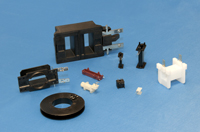Plastic Injection Molding for Wisconsin
What's New with MPM Plastics?
Since MPM's beginning, coil winding bobbins have been at the core of our business. Partnering with hundreds of manufacturers over the years has elevated us to “Experts” in the realm of custom bobbins. Read More....
Terminal Pin Insertion
At MPM, not only do we produce millions of plastic injection molded bobbins annually, but provide many secondary operations such as terminal and pin insertion. We operate many specialized machines that makes this process possible. Read More...
Insert Overmolding
Plastic insert molding is a custom molding process where plastic is injected into the mold to encapsulate (either fully or partially) a part that was placed into the mold just prior to the injection of plastic. Read More...
Molded Plastics
At MPM, “custom” is an everyday term in what we achieve for our customers. When it comes to custom plastic molders, we are simply the best!
MPM is a Proud Member of AGMA
Midwest Precision Molding is now a proud member of the American Gear Manufacturers Association. The global network for technical standards, education, and business information for manufacturers, suppliers, and user of mechanical power transmission components.









